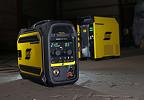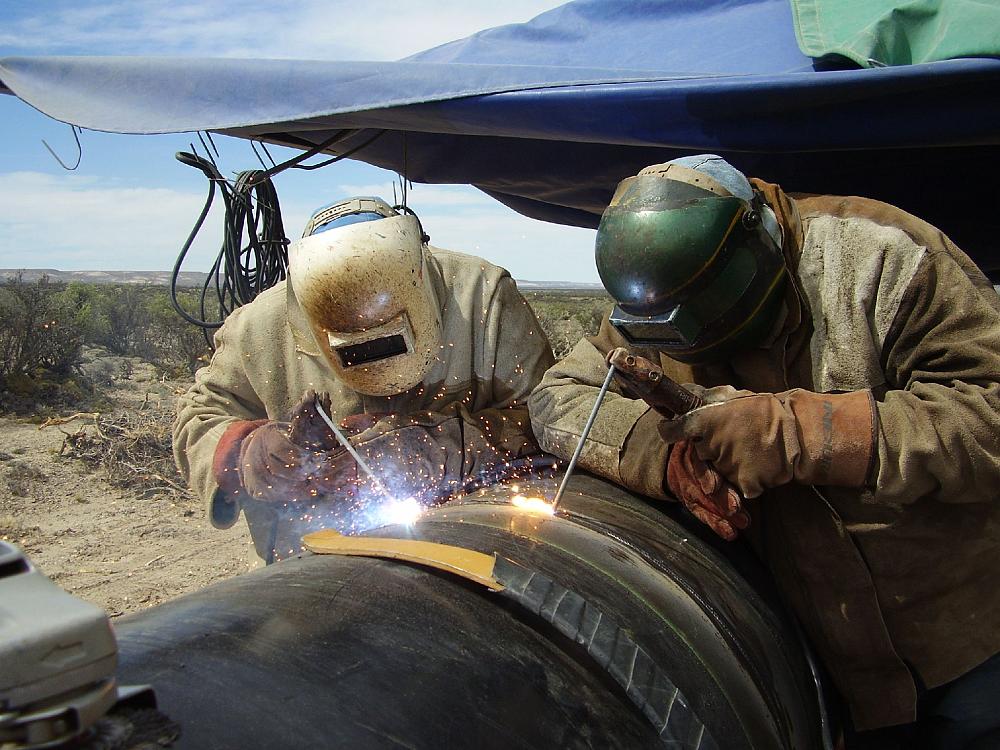- FMA
- The Fabricator
- FABTECH
- Canadian Metalworking
Welding automation takes hold
In pipeline work, stick welding still remains relevant .
- By Nestor Gula
- June 10, 2015
- Article
- Welding
With automation creeping into most industries, it is no wonder that automated processes will be present in pipe welding.
Unlike most welding automation cells, automation for pipeline welding does not take the shape of a robotic arm moving around a pipe. Pipe welding automation consists of a frame with tracks constructed around or adjacent to the joint and a “bug” that moves along the track housing the nozzle that creates the weld.
Setting up the frame and track might seem like a long and laborious process, but it can be quick. “Three times quicker using flux cored automated welding with a manual root pass,” says Gordon Eadie, global pipeline segment manager for ESAB. “The setup is generally done off-line and the welders only come when it is time to weld.
Another team, called the spacers, will set up the joint prior to the welders arriving. All the welders do is weld—nothing else,” he says, explaining how they move from one joint to another and weld, they don’t wire brush or grind.
Automated pipe welding uses wire feed welding and avoids the starts and stops that are inevitable with stick welding when the welder must place a fresh stick in the holder.
“A bug automated system will outperform a rig owner with a stick welder. They are almost incomparable,” says Joe Ryan, marketing segment manager for Miller Electric Mfg. Co. “On a small diameter pipe, the stick will be faster moving from joint to joint because you do not have to turn down all the automated bug system and then reset it on the next joint,” adds Tyler Edwards, pipeline technical sales specialist at Miller Electric Mfg. Co. “You can still achieve the same less than one per cent repair rate with either system. Between the two there is not a whole lot of quality difference.”
In an automatic system, there are just two starts and stops for each joint of the pipe, because there are two welding bugs going up each side of the pipe. “A welding bug can easily achieve 60-inches of welding without stopping whereas a stick welder can have a start and stop every six inches. Any start stop in a welding process has a potential for a defect,” says Eadie.
Using automated welding for pipes pays off when the size of the pipe being welded, or the length of pipe to be welded, justifies the expense of an automated system.
“With manual welding you require an internal line up clamp, and then rigs and welders for the first pass (root bead) and more welding rigs for the second pass (hot pass) and the final fill and cap passes,” says Bruce Clark, director of marketing and export sales with Lincoln Electric Company of Canada. “The number of rigs varies with the diameter of the pipe and how quick you want the line finished. With automatic welders (bugs) you first require a shelter (dog house) to protect the MIG welding arcs from wind that could blow their shielding gas away from the puddle. Next there is a very sophisticated internal line up clamp that also guides two or more internal welding heads laying a root bead on the inside of a machined joint, or alternatively from the outside on to a backing bar that is part of the internal line up clamp. The pipe requires a precision machined surface for this kind of welding.
“Once the root bead is done it is a simple matter of filling and capping the joint with as many external heads as needed for the diameter and thickness of the pipe.
Automatic systems are usually leased for the job along with a crew of specially trained technicians that keep everything running smoothly.”
Although stick welding is seen as a basic welding process, in order to weld pipe to code great skill is needed. “Stick welding pipe is still considered the highest skill set,” says Clark. “The variables the welder has to face are numerous, pipe joints that are out of round, changes in the gap between the two pipes, varying land thicknesses, high low, weather, terrain, the list goes on.”
Stick welding might require more skills but the automatic process is not foolproof. “The way these welding bugs are designed is that a welding engineer will design the welding profile and that will be stored in the bug,” says Eadie. “All the welders will do is position the torch in the start position and press start and in effect just feed it with any changes that have to be made. There is a different skill set involved with setting up the bug.”
The skill set is different but not unequal. An operator of an automated bug system needs to know the welding process to spot any errors. “You still have to understand how to set up the bug, how to place the bug, and how to run the controller,” says Ryan. “Whereas in the stick you need to know the torch angle, electrode angle, there is a lot of eye-hand coordination involved in that but there is a lot less equipment set up. You just set the heat and go. If you are lucky you have a helper that can adjust your heat as you are welding around the pipe.”
There is a lot more equipment involved with automatic pipeline welding and you will need to supply the wire welders with gas and qualified welders are still needed on site. “You still need to have a welder controlling the automated welding systems,” said Edwards. “The welder, or whoever is operating the bug, still needs to know exactly what they are looking for.”
The great thing about stick welding is that it is the most basic form of welding. It requires the least amount of equipment and this is a great advantage when welding in remote locations. “Stick welding requires the minimum amount of complex equipment. There is a welding power source—whether it is an engine driven one or an electrical one. The automated bug is mechanically and electrically complex and it requires additional equipment as well as the welding equipment,” says Eadie. The type of welding done will also determine if stick or an automated system is the right process. “When the length of pipe being laid continuously is too short to warrant all of the equipment needed to do the job, or when the diameter is too small companies turn to rig welders,” says Clark. While a lot of the major pipeline contractors are shifting to automatic welding for their main-line welding, “they will use rig owners to do repair work, tie-ins or bridge crossings and things of that nature,” says Ryan. “You will never get away from stick welding anytime you are welding outdoors because of location. Whenever there is a repair that needs to be ground out and rewelded, that would be primarily done by a rig owner with a stick.”
About the Author
subscribe now


Keep up to date with the latest news, events, and technology for all things metal from our pair of monthly magazines written specifically for Canadian manufacturers!
Start Your Free Subscription- Trending Articles
CWB Group launches full-cycle assessment and training program

Achieving success with mechanized plasma cutting

3D laser tube cutting system available in 3, 4, or 5 kW

Brushless copper tubing cutter adjusts to ODs up to 2-1/8 in.

Welding system features four advanced MIG/MAG WeldModes

- Industry Events
MME Winnipeg
- April 30, 2024
- Winnipeg, ON Canada
CTMA Economic Uncertainty: Helping You Navigate Windsor Seminar
- April 30, 2024
- Windsor, ON Canada
CTMA Economic Uncertainty: Helping You Navigate Kitchener Seminar
- May 2, 2024
- Kitchener, ON Canada
Automate 2024
- May 6 - 9, 2024
- Chicago, IL
ANCA Open House
- May 7 - 8, 2024
- Wixom, MI


















